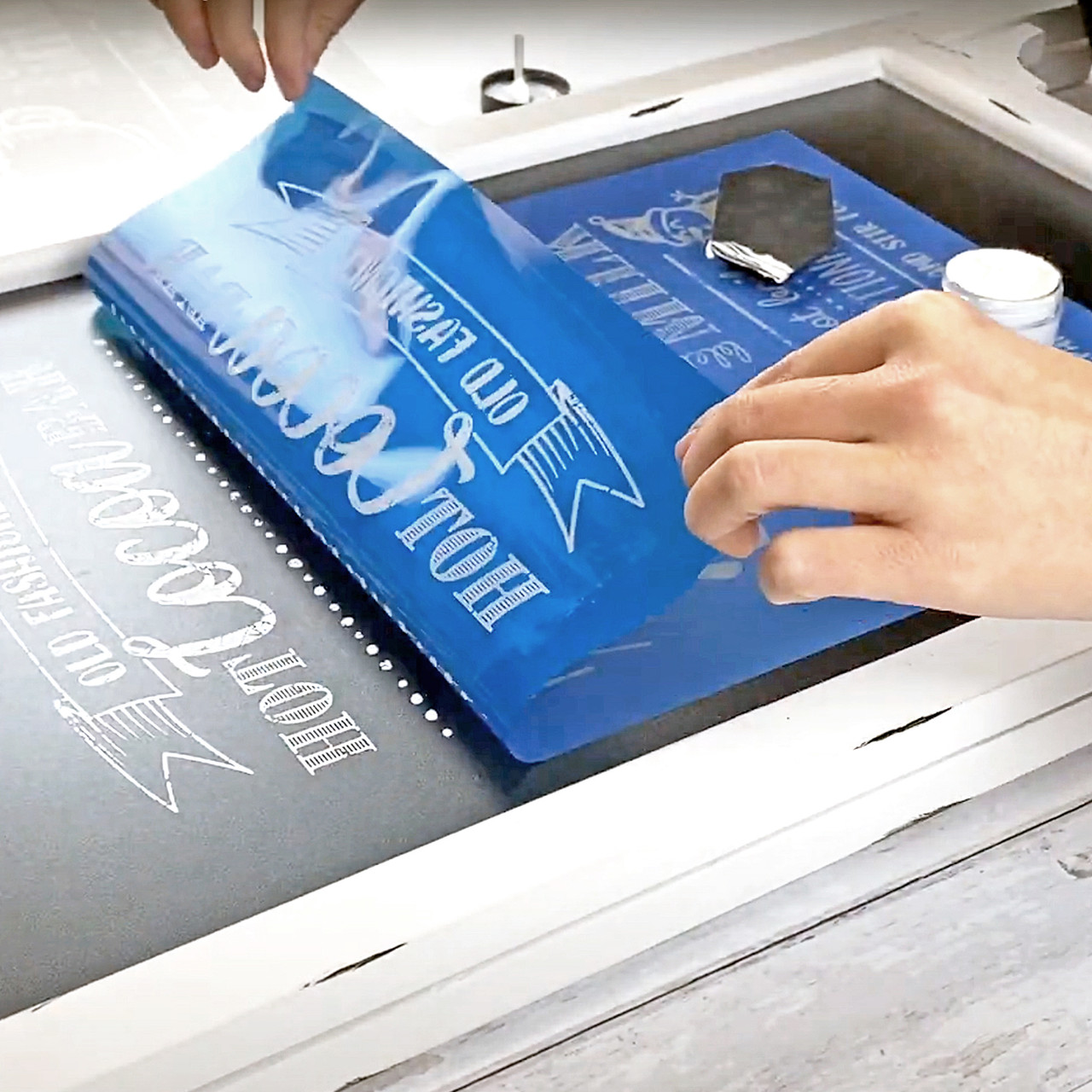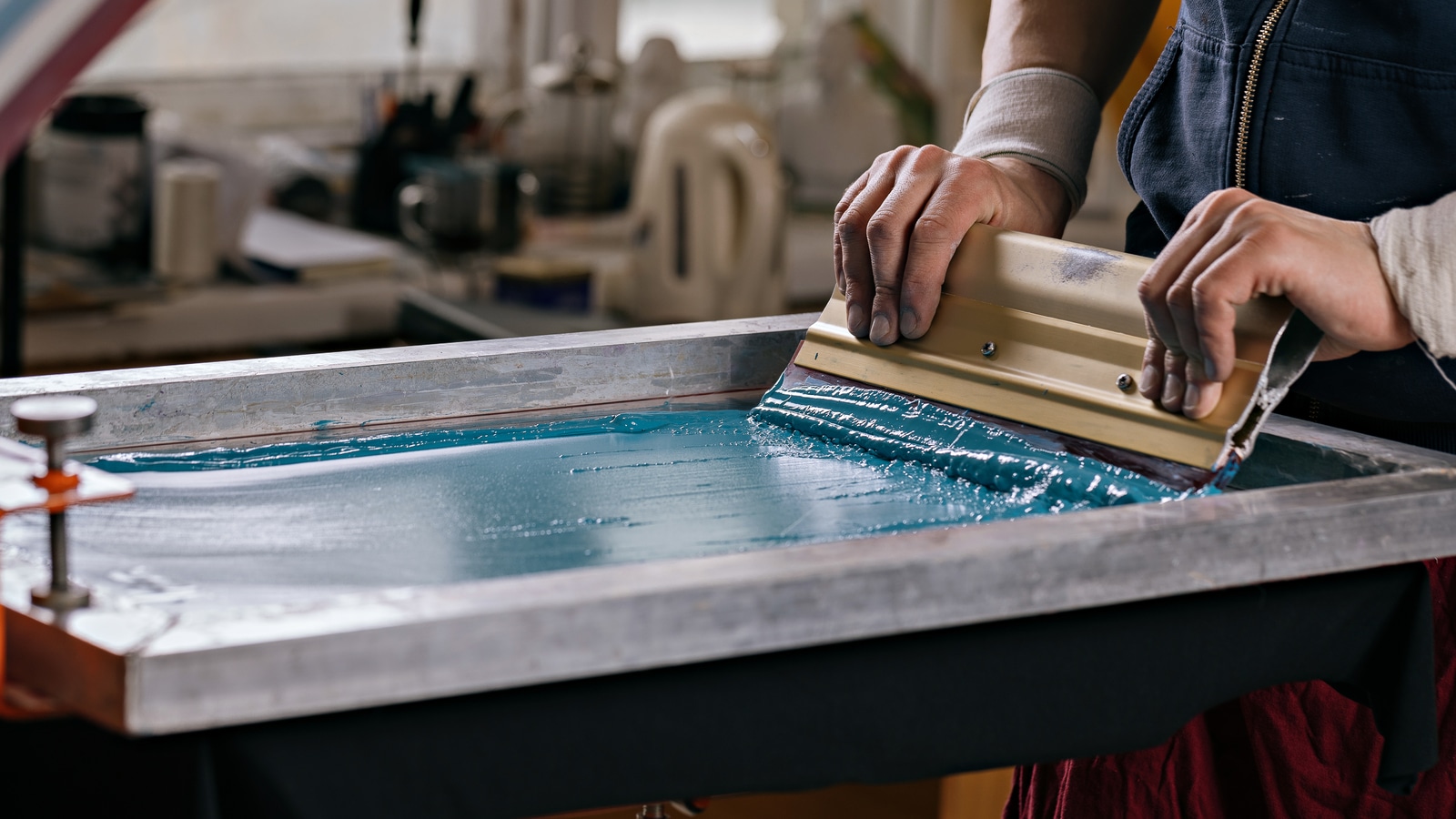Professional Screen Printing Kit for Custom Apparel
Professional Screen Printing Kit for Custom Apparel
Blog Article
Screen Printing Uncovered: Whatever You Need to Understand About Tee Shirt and Garment Printing Strategies
Screen printing is an interesting technique that integrates art with technique, supplying unlimited opportunities for imagination. Prepared to explore the essential aspects that make display publishing an art type?
The Essentials of Display Printing: Just How It Functions
When you dive right into display printing, you'll discover it's both a scientific research and an art. At its core, screen printing involves creating a stencil, or display, that permits ink to pass through only in certain areas.
Position the display over the material, after that use a squeegee to press ink through the screen onto the garment. Each step is important, and understanding them will certainly elevate your display printing skills, transforming simple garments right into distinct, expressive pieces.
Kinds Of Screen Printing Techniques
When you understand the essentials of display printing, it's time to discover the various strategies that can boost your layouts. One popular approach is conventional screen printing, where ink is pushed through a stenciled display. This method is terrific for vibrant, vibrant colors. There's water-based ink printing, which provides a softer feel and is environmentally friendly, but it needs a various technique to healing.
One more alternative is plastisol printing, understood for its durability and vibrant shades, making it a preferred for many brand names. Experiment with halftone printing to develop gradient results and detailed styles.
Necessary Devices for Screen Printing
To accomplish sensational results in display printing, having the right devices is fundamental. You'll need a tough screen printing framework, which holds the mesh that transfers your design onto the garment. Next, invest in high-quality squeegees; these are vital for applying ink uniformly throughout the screen.
Choosing the Right Inks and Materials
When selecting inks and products for screen printing, you require to take into account the sort of ink that functions ideal for your job. Consider textile compatibility to assure your designs look last and great long. Discover environment-friendly ink choices to make your printing process more sustainable.
Kinds Of Display Inks
Choosing the right display ink is essential for attaining vivid, long lasting prints that fulfill your project's needs. There are several kinds of screen inks to analyze. Specialized inks, such as metallic or glow-in-the-dark, can add special results to your layouts.

Material Compatibility Considerations
Comprehending textile compatibility is essential for achieving top notch screen prints, particularly because various materials respond distinctively to different inks. When selecting inks, take into consideration the material kind-- cotton, polyester, or blends. For cotton, water-based inks function well, providing softness and breathability. Polyester, on the various other hand, frequently needs plastisol inks for better bond and vivid colors. If you're printing on blends, you may require to utilize a combination of both kinds. Constantly evaluate your inks on example textile to ensure they stick correctly and keep color honesty. In addition, remember that material weight and appearance can impact the final outcome, so selecting the ideal ink and material combo is important for your project's success.
Eco-Friendly Ink Options
Green inks are becoming a popular selection for display printers that desire to minimize their ecological influence while maintaining quality. When selecting inks, consider water-based inks, which are less unsafe and easier to clean up compared to traditional solvents.
In addition, seek inks made from renewable energies, such as soy or vegetable-based choices. By picking the right inks and products, you'll not just create stunning layouts but also contribute to an extra lasting printing procedure. Make the switch, and your prints will show your commitment to the setting!
Preparing Your Style for Screen Printing

File Format Requirements
To ensure your design looks sharp and vivid on material, you'll require to pay very close attention to file layout demands for display printing. Start with vector data like AI or EPS, as they can be scaled without shedding quality. If you make use of raster pictures, go with high-resolution documents, such as TIFF or PNG, ideally at 300 DPI. Prevent utilizing JPEGs, as they can shed clearness when resized. Additionally, ensure your design has a clear history to stop unwanted white sides on your prints. Maintain color modes in mind; CMYK is conventional for display printing, so transform your try these out RGB develops as necessary - screen printing kit. By adhering to these standards, you'll establish your art work up for a successful print.
Color Separation Techniques
Shade separation is a necessary action in preparing your style for screen printing, and mastering it can considerably boost your print top quality. You'll need to break your design right into individual shades, as each shade needs a separate screen during printing. Start by identifying all the shades in your style and develop layers each. You can utilize software like Adobe Photoshop or Illustrator to separate and different colors successfully. Be specific to save each layer as a different documents, commonly in a format like TIFF or PSD. This accuracy not only guarantees exact color representation yet also enhances the printing procedure. By taking notice of shade separation, you'll attain specialist and dynamic outcomes in your screen-printed garments.
Resolution and Dimension
Accomplishing the ideal results in screen printing begins with guaranteeing your style has the right resolution and size. Ideally, your art work needs to be at least 300 DPI (dots per inch) for sharp, clear prints. If you make use of reduced resolution, your end product might look pixelated and unprofessional.
When it concerns dimension, consider the dimensions of your print location. Layout your artwork to match the last print size, ideally producing it in the real dimensions you'll be publishing. In this manner, you'll stay clear of any kind of unexpected scaling issues.
Constantly examine your design in both vector and raster layouts. Vector graphics can be scaled without losing high quality, making them ideal for screen printing. Preparing properly will ensure your layout looks outstanding on every garment!
Step-by-Step Display Printing Refine
Screen printing is a vibrant process that enables you to produce dynamic layouts on different surface areas. To obtain started, you'll need a screen, solution, and your picked ink.
Put ink onto the display and make use of a squeegee to push the ink through the pattern onto the fabric. Lift the display meticulously and let the print completely dry. You have actually effectively screen published your style.
Tips for Successful Display Printing Projects
While you're diving into your screen printing tasks, bear visit the website in mind that preparation is vital to success. Begin by gathering all your materials-- inks, mops, garments, and screens. A clean work space assists prevent undesirable errors, so clean up before you start.
Following, validate your art work is high-resolution and correctly sized for your garment. Test your screen for correct exposure and clean it extensively to avoid spots. When blending your inks, follow the manufacturer's standards to attain the best consistency.
During printing, apply even pressure with your squeegee for consistent results. Do not hurry; take your time to confirm each print fulfills your standards. After printing, allow your garments completely dry completely before taking care of or packaging them.
Lastly, constantly keep a sample of your job for future referral. In this manner, you can analyze your progression and improve your methods with time. Pleased printing!

Frequently Asked Concerns
The length of time Does It Require To Set up a Screen Printing Job?
Establishing up a display printing task commonly takes around half an hour to an hour. You'll prepare the screens, mix inks, and adjust the press. The moment differs based on complexity and experience, so stay arranged!
Can I Publish on Different Fabric Keys In Using the Very Same Method?
Yes, you can print on different textile types utilizing the exact same technique, yet you'll require to readjust your setups and inks. Some best site fabrics absorb ink differently, so trying out assurances the best outcomes for each and every material.
What Prevail Blunders to Prevent in Screen Printing?
When display printing, prevent common blunders like using the wrong ink, overlooking correct exposure times, or skipping pre-press checks. Constantly test your arrangement and preserve clean screens to guarantee high quality results each time.
Just How Can I Correctly Tidy and Preserve My Screen Printing Tools?
To appropriately tidy and preserve your display printing equipment, you should consistently wash displays with appropriate solvents, inspect squeegees for wear, and assure all devices are kept completely dry and dust-free. Consistency stops costly repair services and enhances efficiency.
Is Display Printing Eco-friendly Compared to Various Other Methods?
Screen printing can be extra environmentally friendly than other techniques, specifically if you use eco-conscious products and water-based inks. By selecting lasting supplies and methods, you minimize waste and minimize your influence on the earth.
Screen Printing Uncovered: Every Little Thing You Required to Know Concerning T-Shirt and Garment Printing Methods
At its core, screen printing includes developing a pattern, or display, that allows ink to pass via only in particular areas. Setting the display over the textile, then utilize a squeegee to press ink via the display onto the garment. One popular method is traditional screen printing, where ink is pushed with a stenciled screen.When selecting inks and products for screen printing, you require to take into account the kind of ink that functions best for your task.
Report this page